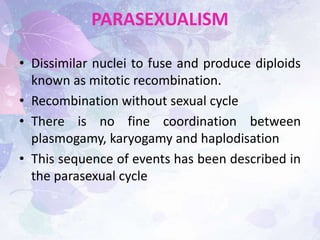PATHOGEN VARIABILITY
- 1. VARIABILITY IN PLANT PATHOGENS PRESENTED BY Arushi Arora A-2016-30-050
- 2. GENETICS AND VARIABILITY OF PLANT PATHOGENS • Dr. E.C. Stakman (U.S. Deptt. Of Agriculture) defined need and use of variability in fungi • Pathogen population mutates with time and environmental conditions like stress • In nature variability in organisms may be due to: HYBRIDIZATION MUTATION
- 3. • When progenies show variations in characterstics from parents it is called as a VARIANT. • Physiological specialization: – with in the species of a pathogen there exist certain individuals that are morphologically similar but differs w.r.t their physiology, biochemical characters and pathogenicity and are differentiated on the basis of their reaction on certain host genera or cultivars.
- 4. • Physiological race: – a group of population within a species which have ability of infecting a particular genotype and do not differ in their morphology but have physiological differences such as a specific host or food type or pathogenicity • Variability: it is the property of an organism to change its characters from one generation to the other
- 5. • With in species or f.sp. There are further subgroups of individual that infect different varietes of the host– such subgroups are called RACES/ STRAINS • A sub-group within a species or race, characterized by a common possesion of single of few new characters and differ only in few minor characters from parents are called BIOTYPES
- 6. BREAKDOWN OF RESISTANCE: • This term is used when a previously resistant variety suddenly develops disease. • It implies that the host has changed, that the resistance mechanisms no longer work. • New pathogen races have developed because of selection pressure that was put on population by the host resistance mechanism
- 7. Races are defined by ability to develop on specific host genotypes (varieties, cultivars, hybrids, etc.). Races are identified by ability to cause disease on members of a set of 10 differential varieties that contain specific resistance genes. V1 V2 V3 V4 V5 V6 V7 V8 V9 V10 Race x x x 14 x x x 27 x x 31
- 9. HYBRIDIZATION • Mating of dissimilar strains or species of fungi • 2 haploid nuclei (1N) with different genetic material combine to form a diploid nucleus(zygote) • Eg. Basidiospores( haploid) from different races often infect the same leaf or plant Chances of dikaryotization high
- 10. HERTEROKARYOSIS Hyphae or parts of hyphae contain nuclei, which are genetically different, generally of two different kinds. This condition is known as heterokaryosis . The phenomenon is commonly brought about by hyphal anastomosis between mycelia of two parental genotypes. In Ascomycotina and Basidiomycotina
- 11. PARASEXUALISM • First demonstrated by Pontecorvo (1956) in Aspergillus nidulans. Parasexualism is the process by which genetic recombination can occur with in fungal heterokaryon : • Stage 1: heterokaryosis • Stage 2: recombination
- 12. PARASEXUALISM • Dissimilar nuclei to fuse and produce diploids known as mitotic recombination. • Recombination without sexual cycle • There is no fine coordination between plasmogamy, karyogamy and haplodisation • This sequence of events has been described in the parasexual cycle
- 13. PARASEXUALISM IMPORTANCE • In rust fungi as P. graminis tritici, mitotic recombination may represent a most important method of generating new races especially in countries such as India where sexual stage of the fungus is rare due to scarcity of the alternate host, the barberry. • Common in deutromycotina
- 14. RECOMBINATION • When two haploid nuclei (1N) containing different gnentic maeterial unite to form diploid (2N) nucleus (Zygote,) when under go meiotic division produce new haploid . • Recombination of genes occurs during meiotic division of zygote as a result of cross over in which part of chromatid of one chromosome of a pair are expressed with that of the other • Important in fungi Puccinia graminis.
- 16. Cereal rust fungus variability • Races of rust pathogen Puccinia graminis differ from each other in shape and size of uredospores but principle diffrence between them is • Preference for groups of host in different members of graminae Eg. Race tritici, secalis, avenae etc
- 17. MUTATION Sudden heritable change in genetic material of an organism Mutation represent change in sequences of the bases in DNA either by – substitution or by deletion or addition Mutations are spontaneous May occur due to: 1. Improper cell division 2. Abnormalities during division 3. Physical radiations 4. Mutagenic chemicals
- 18. CYTOPLASMIC ADAPTATION • Pathogens develop capicity to perform biochemical reactions which were not present in them earlier • Can utilize protoplasm of unfavourable host. • Adaptation to new cytoplasm
- 19. Three types of cytoplasmic adaptatibility I. Pathogen may aquire tolerance to toxic materials II. Utilization of new types of cytoplasm III. Change in virulence
- 20. VARIABILITY IN BACTERIA Transformation transduction Conjugation
- 21. CONJUGATION • Transfer of DNA from one bacterial cell to another Donor cell (F+) transfers DNA to recipient cell (F- ) • In this two compatible bacteria come in contact and exchange the portion of plasmid or chromosome through conjugation bridge or pilus
- 23. TRANSFORMATION DNA taken up from external environment by absorption
- 25. TRANSDUCTION Transfer of bacterial genes with a bacteriophage
- 28. VARIABILITY IN VIRUSES Recombination • May results from mixed infection of two strains of the virus • Occurs mostly during replication Mutation – Results from nucleotide changes in the coding regions due to addition or deletion or replacement. – Ultimately leads to functional changes in the genes.
- 29. REFRENCES • R.S. Singh, INTRODUCTION TO PRINCIPLES OF PLANT PATHOLOGY, Oxford & IBH Publishing CO. pg.200-208 • http://agriinfo.in/default.aspx?page=topic&su perid=3&topicid=2131 • http://www.columbia.edu/itc/hs/medical/pat hophys/id/2008/Notes.pdf






























